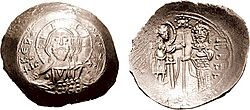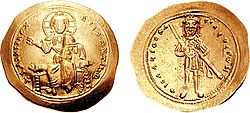Histamenon facts for kids
The Histamenon (which means "standard coin" in Greek) was a special gold coin used in the Byzantine Empire. It was created in the 960s to tell it apart from a slightly lighter gold coin called the tetarteron. To make them different, the Histamenon was made wider and thinner than older gold coins. It also became curved, like a bowl, a shape called "scyphate."
Later, people often just called it the stamenon. This coin was no longer made after 1092. Much later, in the 12th and 13th centuries, the name stamenon was used for other curved coins made of billon (a mix of metals) and copper.
The Birth of the Histamenon Coin
For hundreds of years, since Emperor Constantine I (r. 306 – 337) introduced it in 309, the main coin of the Byzantine Empire was the solidus. This was a very high-quality gold coin. It always weighed 4.55 grams and was made of pure 24-carat gold.
However, Emperor Nikephoros II Phokas (r. 963 – 969) decided to introduce a new coin. He called it the tetarteron. This new coin was a bit lighter than the original solidus, having 2 carats less gold. To show that the original solidus still followed the old standard, it was given a new name: Histamenon. The word Histamenon comes from a Greek word meaning "to stand up," suggesting it stood by the traditional rules.
Historians aren't completely sure why this change happened. But old Byzantine writers thought it was for money reasons. They said that Emperor Nikephoros collected taxes in the full-weight Histamenon coins but paid people back with the lighter tetarteron. Even though the tetarteron was lighter, the government said it had the same value as the full-weight coin.
At first, the Histamenon and tetarteron coins looked almost the same, except for their weight. But during the time of Emperor Basil II (r. 976 – 1025), the tetarteron started to be made thicker and smaller. At the same time, the Histamenon became thinner and wider.
It was only when Constantine VIII (r. 1025 – 1028) ruled alone that the two coins also started to look different in their designs. By the mid-11th century, the tetarteron was about 18 mm wide and weighed around 3.98 grams. This was three carats less gold than the Histamenon. The Histamenon (sometimes called stamenon by 1030) was now about 25 mm wide.
Under Emperor Michael IV the Paphlagonian (r. 1034 – 1041), the Histamenon began to be made with a slight curve, like a bowl. This shape is called "scyphate." This was probably done to make the thin coin stronger and harder to bend. Even though some flat coins were still made, the curved ones became much more common from the time of Constantine IX (r. 1042 – 1055) onwards. They became the standard shape under Isaac I Komnenos (r. 1057 – 1059). These curved coins were known as histamena trachea or simply trachea, which means "rough" or "uneven" because of their shape.
When the Histamenon Lost its Value and Disappeared

.
Starting with Emperor Michael IV, who used to be a money lender, the amount of gold in the Histamenon coins began to be slowly reduced. This is called "debasement." After a period of being fairly stable around 1055–1070, the amount of gold in the coins dropped very quickly during the difficult years of the 1070s and 1080s.
For example, the coins made during the rule of Michael VII Doukas (r. 1071 – 1078) still had about 16 carats of gold. But by the time Alexios I Komnenos (r. 1081 – 1118) became emperor, the nomismata coins had almost no gold at all.
Because of this problem, Alexios I made big changes to the money system in 1092. He replaced the old, debased gold coins, both the Histamenon and the tetarteron, with a brand new, high-quality gold coin called the hyperpyron.
After this, for the next two centuries (the 12th and 13th centuries), the word stamenon became a general term. It was used to describe other curved coins, like those made of billon and copper, that were also called trachea because of their shape.
Sources
- "The Oxford Dictionary of Byzantium".. (1991). Oxford and New York: Oxford University Press.



